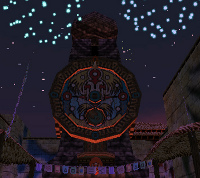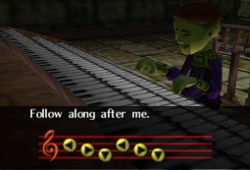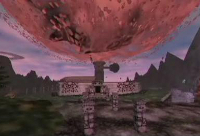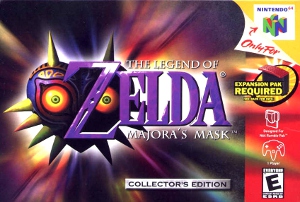Review: Majora’s Mask by Axle the Beast
Posted on November 27 2010 by Axle D. Wilder
 Majora’s Mask seems like a very unusual sort of Zelda game. Most games in the series have used a template of game design and storytelling very similar to your standard fantasy epic. Majora’s Mask was a different sort of story. Ironically, while the stakes were far higher than they’ve ever been, we were dealing with a very personal journey, and the story dealt more with the every day dealings of the people than it did with the battle against evil. Surreal imagery, deep character development, personal involvement, a constant sense of mystery, overarching themes, the 3-Day Cycle, the transformation masks, a spike in difficulty… all of these things helped set Majora’s Mask apart from other Zelda games and give it its own identity. Yet at the same time, Majora’s Mask was not so unlike other Zelda games because while it FELT different it FUNCTIONED much the same. There are differences, yes, as there are between all Zelda games. But it wasn’t a revolution, only a refinement.
Majora’s Mask seems like a very unusual sort of Zelda game. Most games in the series have used a template of game design and storytelling very similar to your standard fantasy epic. Majora’s Mask was a different sort of story. Ironically, while the stakes were far higher than they’ve ever been, we were dealing with a very personal journey, and the story dealt more with the every day dealings of the people than it did with the battle against evil. Surreal imagery, deep character development, personal involvement, a constant sense of mystery, overarching themes, the 3-Day Cycle, the transformation masks, a spike in difficulty… all of these things helped set Majora’s Mask apart from other Zelda games and give it its own identity. Yet at the same time, Majora’s Mask was not so unlike other Zelda games because while it FELT different it FUNCTIONED much the same. There are differences, yes, as there are between all Zelda games. But it wasn’t a revolution, only a refinement.
Visuals
 Majora’s Mask boasts the best graphics on the Nintendo 64. Because of the expansion pack and its release at the climax of the Nintendo 64’s lifespan, it was really the best it could have been in this department. While one could compare it to the graphics of newer games and say it doesn’t look that good anymore, I really think more so than other games of its era Majora’s Mask has aged gracefully. Its graphics are the same as those of Ocarina of Time, although refined with a higher polygon count and other details. Like Ocarina of Time it managed a fairly realistic look (as much as was possible with the technology available) while still maintaining a sense of style. The style they maintained was a different sort than you found in Ocarina of Time, however.
Majora’s Mask boasts the best graphics on the Nintendo 64. Because of the expansion pack and its release at the climax of the Nintendo 64’s lifespan, it was really the best it could have been in this department. While one could compare it to the graphics of newer games and say it doesn’t look that good anymore, I really think more so than other games of its era Majora’s Mask has aged gracefully. Its graphics are the same as those of Ocarina of Time, although refined with a higher polygon count and other details. Like Ocarina of Time it managed a fairly realistic look (as much as was possible with the technology available) while still maintaining a sense of style. The style they maintained was a different sort than you found in Ocarina of Time, however.
Ocarina of Time’s art style was a fairly standard affair for a Japanese game; a pretty basic anime style complete with large eyes, unrealistic proportions, and more cartoony designs thrown in for the odder characters. With Majora’s Mask it was similar, but the style was much darker. More shadows, and more surreal and creepy characters. The character designs are more bizarre in Majora’s Mask, and the darker art style comes across in the game’s models as well.
The darker aesthetic is one of the things that helps give Majora’s Mask its own identity. More so than other qualities of the game, the art style stays unique throughout, and never feels quite like any other Zelda game. My personal feelings of the art style are that it has a darker tone, but first and foremost it is strange and surreal. Surreal and mysterious. And that is much the tone of the entire game. I liked it a lot, it was very attractive and it fit the game very well.
The graphics in Majora’s Mask are top of the line for the Nintendo 64. They looked awesome then and they still look very good. The art style is very unique when compared to the other Zelda games. With its surreal, dark anime look, it is very attractive and works well with the rest of the game’s feel. 10/10.
Audio
Like the graphics, the audio of Majora’s Mask is very, very similar to Ocarina of Time. The sound quality is identical, and it borrows many sounds and songs directly from that game. The changes are chiefly in the new additions, and how they affect the overall tone.
 The music is familiar. There are a lot of tracks from Ocarina of Time, like the songs for Zora’s Domain, Goron City, Lon Lon Ranch, random caves, and more. These function as the songs for areas that are very similar to their Ocarina of Time counterparts, like the homes of the different tribes. The game has many new tracks, however, including a new rendition of the classic overworld theme for Termina Field. All of its new tracks, however, are very much in keeping with the art style: darker and more surreal. Many of the tracks are strange, mysterious, creepy, or even dreamlike. And several songs feature prominently in the game, with many variations of them playing at different points. The first is the standard area song which is a low-key, sad track that has four arrangements in the game for the four major areas. Its basic nature fits the troubled state all the areas are in when you first visit them, and fittingly when they have been helped it is replaced by the standard Termina Field music. Each unique version of the song has alterations to fit the area’s theme, from wintery, to tropical, to haunting. The Song of Healing is an important Ocarina song in the game, and in a way the game’s theme-song. It strongly conveys the emotion of the game and the story, and accompanies many of the game’s dreamlike sequences. Similarly, we have the Oath to Order. Another Ocarina song, there are many variations of it that are all played during events surrounding the Four Giants. This song also plays during dreamlike sequences and it perfectly conveys the mystery, sadness, and hope these characters provide. Finally, there is Majora’s theme, which plays during appearances of the game’s antagonist, the Skull Kid, as well as during the intro. Additional mixes of the song play during the fight against Majora. This song perfectly fits Majora, the enemy of the game, and its chilling sound gives a great sense of his presence.
The music is familiar. There are a lot of tracks from Ocarina of Time, like the songs for Zora’s Domain, Goron City, Lon Lon Ranch, random caves, and more. These function as the songs for areas that are very similar to their Ocarina of Time counterparts, like the homes of the different tribes. The game has many new tracks, however, including a new rendition of the classic overworld theme for Termina Field. All of its new tracks, however, are very much in keeping with the art style: darker and more surreal. Many of the tracks are strange, mysterious, creepy, or even dreamlike. And several songs feature prominently in the game, with many variations of them playing at different points. The first is the standard area song which is a low-key, sad track that has four arrangements in the game for the four major areas. Its basic nature fits the troubled state all the areas are in when you first visit them, and fittingly when they have been helped it is replaced by the standard Termina Field music. Each unique version of the song has alterations to fit the area’s theme, from wintery, to tropical, to haunting. The Song of Healing is an important Ocarina song in the game, and in a way the game’s theme-song. It strongly conveys the emotion of the game and the story, and accompanies many of the game’s dreamlike sequences. Similarly, we have the Oath to Order. Another Ocarina song, there are many variations of it that are all played during events surrounding the Four Giants. This song also plays during dreamlike sequences and it perfectly conveys the mystery, sadness, and hope these characters provide. Finally, there is Majora’s theme, which plays during appearances of the game’s antagonist, the Skull Kid, as well as during the intro. Additional mixes of the song play during the fight against Majora. This song perfectly fits Majora, the enemy of the game, and its chilling sound gives a great sense of his presence.
There isn’t a lot to say about the audio aside from the music. Many sound effects are recycled from Ocarina of Time, while other times characters who originally came from that game are finally given their own sounds. The different forms of Link have variations of his voice to fit them better, and the rest of the game’s sound effects do their job.
The game’s sounds are good, and its music is amazing. Plenty of reference to Ocarina of Time in its soundtrack, with plenty of new themes that happen to include some of my favorites in the series. There is some repetition, but I believe most of it keeps from being irritating, and I feel the music overall excellently conveys the appropriate emotion and feeling to any given scene or area. 10/10.
Story
Majora’s Mask doesn’t have a very original concept for a story. An innocent but troubled character (the Skull Kid) puts on an evil mask that possesses him. From there, it goes straight to the standard idea of an ancient evil threatening the world with the apocalypse. Majora’s Mask has a very basic story, but how it tells it is completely different and this is one quality of the game that makes it stand out quite a bit.
The other Zelda games progress the story by moving you through the dungeons and having you collect quest items. The progression of the story relied entirely on the linear events you went through to get to the end. Majora’s Mask did this very differently. There was a story to be had if you played through it in a linear fashion, but it was very basic. There was a high amount of depth, however, and it came from going off the beaten path and diving into the side content. All of the NPCs had their own stories, and if you took the time to help them and go through all of the sidequests, you’d get a bigger picture of their lives and the overall story; all the people were connected.

This sidequest focus in both the gameplay and the story is a bit of a double-edged sword:
On one hand, it adds a high degree of depth to the game. In my opinion Majora’s Mask surpasses the storyline depth of all the other games in the Zelda series because of its sidequest focus. It also added an entirely new layer of enjoyment to the side content. And for the first time in a Zelda game, I felt very attached to all of the characters, not just the main ones leading the plot. In fact, at times I cared more for many of the side characters than I did for the main ones.
On the other hand, all of this good stuff is time and effort taken directly from the main plot. The primary events that function as the linear story progression you see in other Zelda games are of a much less impressive nature. They’re fairly predictable, and while they carry the game’s signature mysterious and surreal qualities, they aren’t as noteworthy as those of other games. Gamers who prefer the sidequests to be secondary content, with the main story being the core experience, could be disappointed.
I myself didn’t mind this sidequest focus, and it very much enhanced my experience while playing the game. The linear portions of the story were decent, and with the sidequest depth added on, the story was amazing in my eyes. 10/10.
Gameplay
Interestingly, the basic gameplay is where Majora’s Mask might become something undesirable for some gamers. The game is a lot harder than most Zelda games, especially any of the modern ones. I myself struggled through the game when I first played it, but I still had fun and all subsequent playthroughs have not been nearly as hard. I have however heard from a lot of people who had a high degree of difficulty with the game, so Majora’s Mask might not be found so appealing by casual gamers.
 There are other things different about the gameplay of Majora’s Mask besides the difficulty. To start, obviously the 3-Day Cycle. This is another way that Majora’s Mask might not appeal to a casual audience. The 3-Day Cycle puts a time limit on you, and while I never had trouble with it once I slowed it with the Song of Inverted Time, some people have and even if you don’t it’s an added sense of pressure. You’ll be a lot more tense playing through the game. Then there’s how the 3-Day Cycle ties into the save system, in that you have to reset the 3-Day Cycle in order to fully save. Otherwise you’ll have to use the Owl Statues to make a temporary continue save file. I thought this save system was actually great, but it only works for more hardcore gamers who are willing to sit down for several hours to complete a section of the game. I would not call the 3-Day Cycle or saving system a problem necessarily, but they are things that might turn off some gamers. I personally liked them and found them very unique, adding to the uniqueness of both the game’s feel and the gameplay itself.
There are other things different about the gameplay of Majora’s Mask besides the difficulty. To start, obviously the 3-Day Cycle. This is another way that Majora’s Mask might not appeal to a casual audience. The 3-Day Cycle puts a time limit on you, and while I never had trouble with it once I slowed it with the Song of Inverted Time, some people have and even if you don’t it’s an added sense of pressure. You’ll be a lot more tense playing through the game. Then there’s how the 3-Day Cycle ties into the save system, in that you have to reset the 3-Day Cycle in order to fully save. Otherwise you’ll have to use the Owl Statues to make a temporary continue save file. I thought this save system was actually great, but it only works for more hardcore gamers who are willing to sit down for several hours to complete a section of the game. I would not call the 3-Day Cycle or saving system a problem necessarily, but they are things that might turn off some gamers. I personally liked them and found them very unique, adding to the uniqueness of both the game’s feel and the gameplay itself.
The game also differs from other titles due to the presence of the masks. Saying so is a bit strange, however, as the masks really are just another category of item, which you regularly collect as you do items in any other game. Majora’s Mask has less items than most Zelda games, but at the same time it has far more because of the masks. Most of the masks are actually useless, or only used in one situation. Only a handful have a regular use, and among them are the transformation masks. Allowing you to turn into a Deku, Goron, or Zora, these masks allow you to finally control other races from the Zelda series. This was an awesome addition to the gameplay and the mechanics for the different forms are great. My only complaints revolve around the Deku Mask and Zora Mask really, and come from a game design standpoint. I felt that the Deku was largely useless. Aside from his ability to hover after popping out of flowers, he was never really used much outside of the earliest point in the game. The Deku was more like an intro form rather than something that was useful throughout the whole game. The same could be said of the Zora although it was acquired at a later point. There weren’t many bodies of water where the Zora was useful outside of its own area. I suppose in a way the Goron was similar, although since it was stronger than the Deku and not restricted to certain environments like the Zora, it was usable in most areas even if not required. Hilariously, the Goron is probably the least fun of the three to play as; the Goron has only two main uses, and that’s to be either incredibly slow and sluggish, or to be fast and blast through the area in the blink of an eye.
And of course, the gameplay separates itself from that of other Zelda games in the focus on sidequests as opposed to focus on the linear progression. This effects the gameplay in the exact same way it does the story. If you like the side content, Majora’s Mask is going to be the best game ever for you. If you like the linear game first and foremost, you’re going to be disappointed. But overall the gameplay of Majora’s Mask is very good, just not for everyone or at least it won’t be the FAVORITE for everyone.
One thing I can say about the gameplay that could be considered outright bad is some aspects of the dungeon design. While Majora’s Mask features some of my favorite dungeons in the whole series, some aspects of them are way too unforgiving. You’ll have to redo entire areas of the dungeon if you have to return to them for missed items or switches, or if you fell. Again this is something for hardcore gamers I guess, but even I found it annoying and unnecessary. You shouldn’t have to redo a challenge you already completed and there are probably ways they could have handled this, like with warping. Additionally, the Bottom of the Well mini-dungeon is just annoying with no plus points. 9.8/10.

The verdict?
Overall Majora’s Mask is a breathtaking game. It managed to implement many new ideas into the core Zelda formula without disrupting said formula. It’s a Zelda game, through and through, but slightly different and catered to a more hardcore audience. If you are casual as a gamer, you might still enjoy Majora’s Mask, but probably not as much as other Zelda games unless you’re all about the story and atmosphere, in which case you might appreciate the game’s unique take on both.
Majora’s Mask is my favorite Zelda game of all-time. As a hardcore gamer, the experience it provided was just about perfect for me. I personally find Majora’s Mask to be the most perfect Zelda game, the most devoid of flaws. But I also realize this is because of my preference that I do not see its points of contention as flaws. The few shortcomings I recognize I believe are completely offset by the game’s greatness.
10/10 as a Zelda game.
10/10 as a video game.



